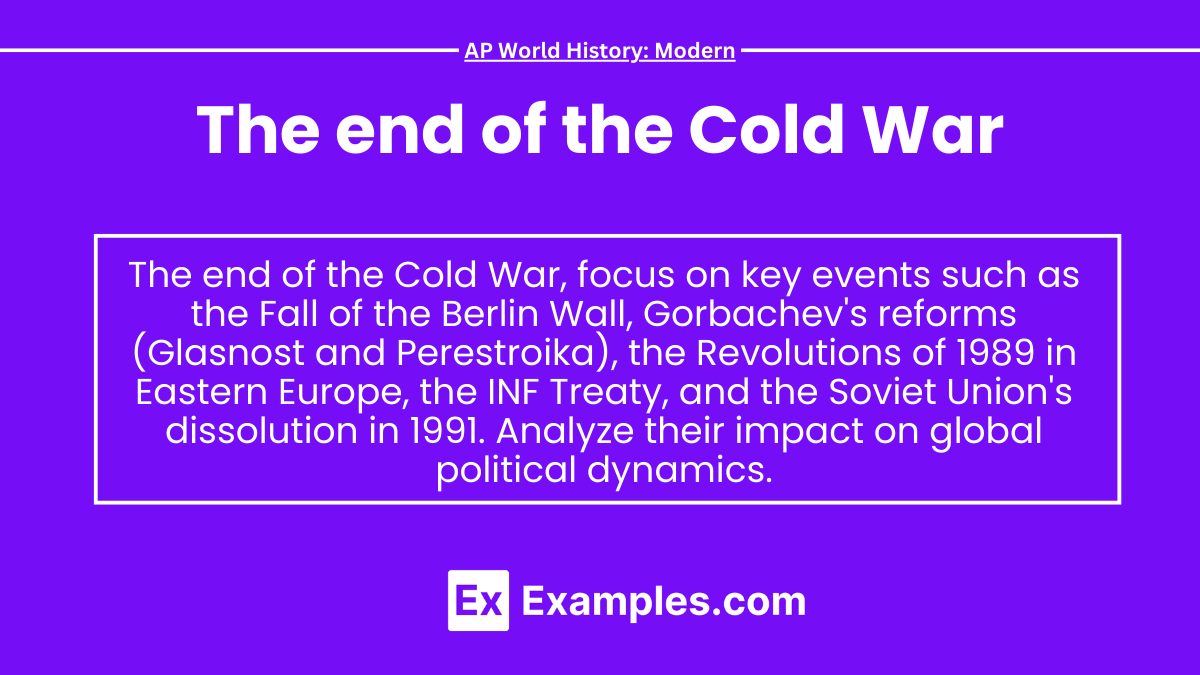The end of the Cold War
The end of the Cold War marked the collapse of the Soviet Union and the fall of communism in Eastern Europe, occurring between 1989 and 1991. Key factors included economic struggles in the Soviet Union, Gorbachev’s reforms (Glasnost and Perestroika), rising demands for freedom in Eastern Europe, and diplomatic efforts with the United States, leading to peaceful revolutions.
Learning Objective
In studying “The End of the Cold War” for AP World History: Modern, you should learn to identify the key events and policies that contributed to the dissolution of Cold War tensions, including the roles of leaders like Mikhail Gorbachev and Ronald Reagan. Analyze the impact of economic challenges, social movements, and diplomatic efforts on the collapse of the Soviet Union and the shifting balance of power globally. Evaluate the consequences of the Cold War’s end on international relations, the emergence of new geopolitical challenges, and the spread of democratic movements.
1. Background of the Cold War’s End
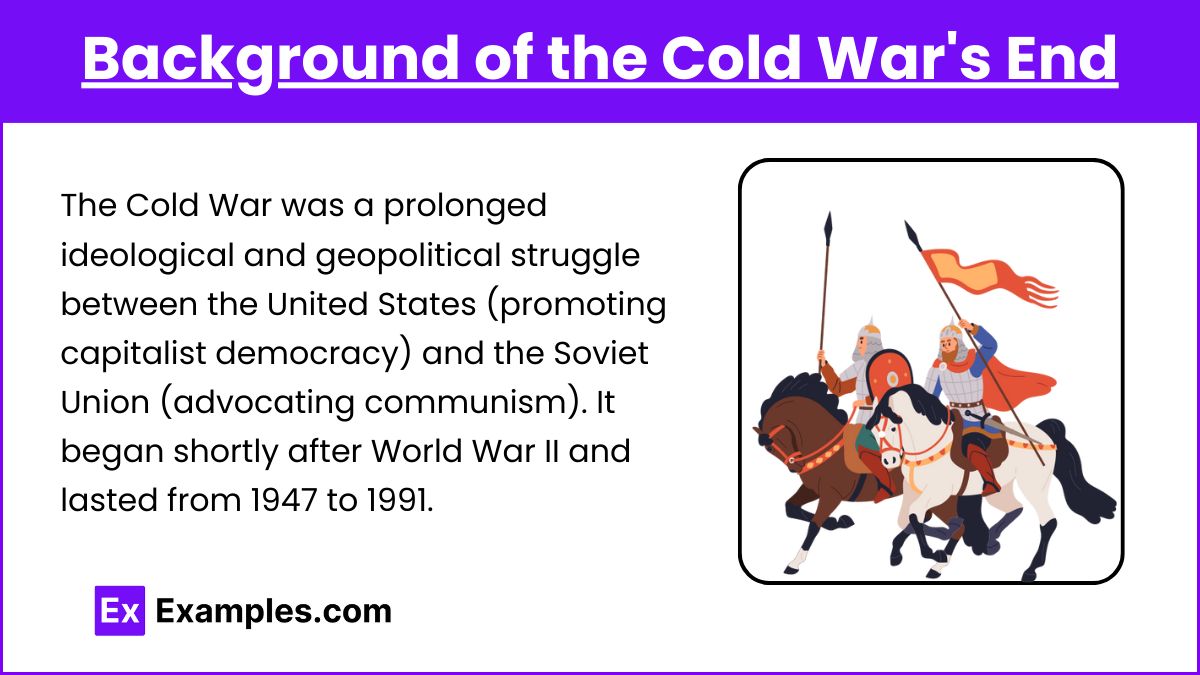
The Cold War was a prolonged ideological and geopolitical struggle between the United States (promoting capitalist democracy) and the Soviet Union (advocating communism). It began shortly after World War II and lasted from 1947 to 1991. This rivalry didn’t involve direct large-scale warfare between the two superpowers but was characterized by proxy wars, nuclear arms races, political confrontations, and ideological battles.
By the 1980s, the Soviet Union was facing multiple internal and external challenges that weakened its position, making it difficult to sustain the Cold War’s momentum. Economic stagnation, political unrest, and the rise of demands for greater freedoms among its citizens and in satellite states contributed significantly to the Soviet Union’s decline.
2. Key Factors Leading to the End of the Cold War
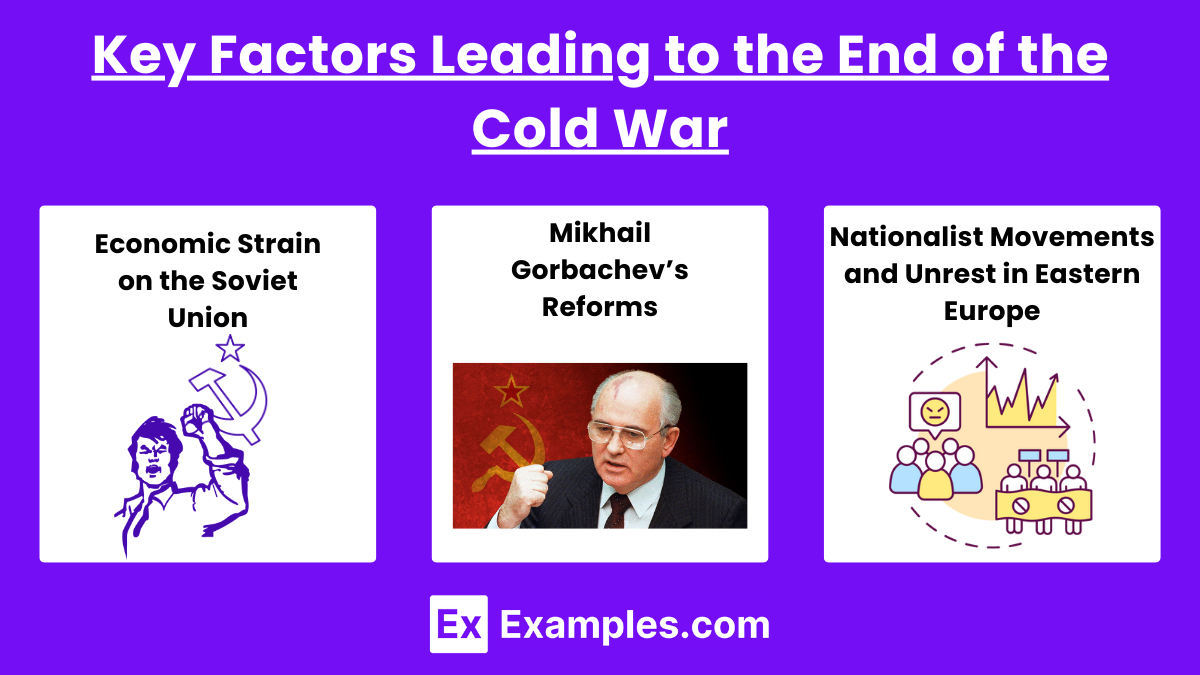
Economic Strain on the Soviet Union
- The Soviet economy was suffering from long-term inefficiencies due to centralized planning, overemphasis on heavy industry, and neglect of consumer goods.
- Military expenditure was extremely high as the Soviet Union tried to keep up with the United States in the arms race, especially in developing nuclear weapons and maintaining a large standing army.
- Additionally, the cost of maintaining control over Eastern European satellite states and supporting communist allies worldwide placed a huge burden on the Soviet economy.
Mikhail Gorbachev’s Reforms
- In 1985, Mikhail Gorbachev became the leader of the Soviet Union. Recognizing the need for change, he introduced two major reforms: Glasnost and Perestroika.
- Glasnost (Openness): Aimed at creating a more open society by encouraging freedom of speech, reducing censorship, and allowing open discussions about the government and its policies. This was a major shift as criticism of the government had previously been severely restricted.
- Perestroika (Restructuring): Focused on reforming the Soviet economy by introducing elements of the market economy, decentralizing economic controls, and encouraging some private ownership. However, these reforms faced resistance and led to confusion and instability, as many did not fully understand how to transition to a semi-market system.
Nationalist Movements and Unrest in Eastern Europe
- Eastern European countries like Poland, Hungary, East Germany, and Czechoslovakia had been under Soviet influence since the end of World War II.
- By the late 1980s, these countries experienced growing discontent and protests against communist rule, inspired by Gorbachev’s more liberal policies. Nationalist movements gained momentum, and people demanded more independence and democratic governance.
3. The Role of the United States in the End of the Cold War
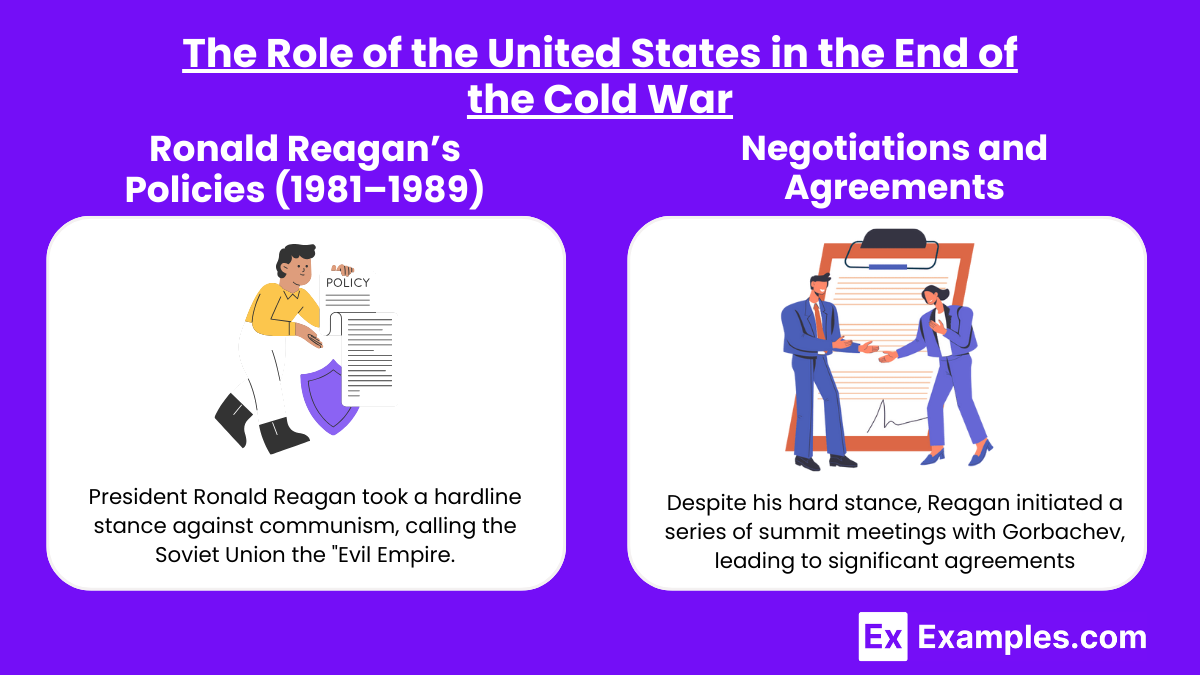
Ronald Reagan’s Policies (1981–1989)
- President Ronald Reagan took a hardline stance against communism, calling the Soviet Union the “Evil Empire.”
- He launched a massive military buildup, including the Strategic Defense Initiative (SDI) or “Star Wars,” a plan to develop a missile defense system. This put additional pressure on the Soviet economy, as they tried to match U.S. military spending.
Negotiations and Agreements
- Despite his hard stance, Reagan initiated a series of summit meetings with Gorbachev, leading to significant agreements:
- The INF Treaty (1987): Both superpowers agreed to eliminate all intermediate-range and shorter-range missiles. This treaty was a major step toward reducing the threat of nuclear war and marked a turning point in U.S.-Soviet relations.
4. Impact and Significance of the Cold War’s End
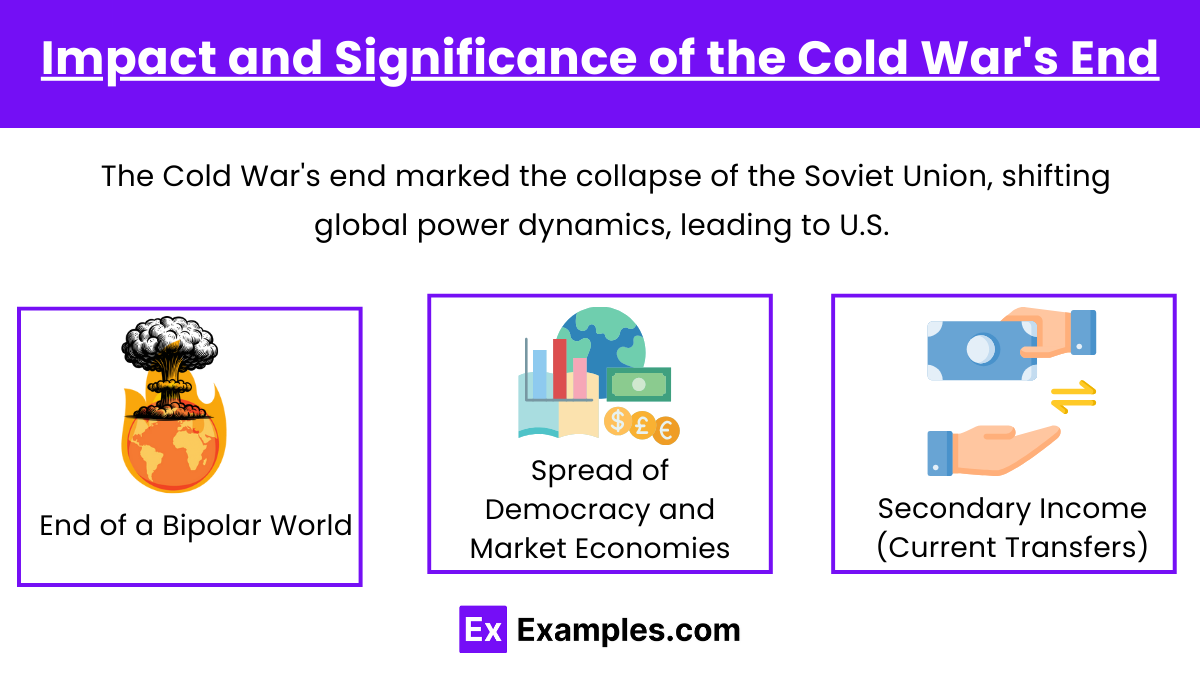
The Cold War’s end marked the collapse of the Soviet Union, shifting global power dynamics, leading to U.S. dominance, democratization in Eastern Europe, and reshaping international relations with reduced nuclear tensions.
End of a Bipolar World
- The world shifted from a bipolar structure (U.S. vs. Soviet Union) to a unipolar system, with the United States as the sole superpower.
- The end of the Cold War led to a significant reduction in global tensions and fears of nuclear conflict, allowing for a new era of international cooperation.
Spread of Democracy and Market Economies
- Many former communist countries transitioned to democratic forms of government and adopted market economies.
- Nations like Poland, Hungary, and Czechoslovakia began integrating into Western institutions, such as the European Union (EU) and NATO.
Global Changes and New Challenges
- The dissolution of the Soviet Union resulted in the emergence of new independent states with varying degrees of political and economic stability.
- It also meant that many former communist countries faced significant challenges in transitioning to capitalist economies, leading to periods of economic hardship.
Examples
Example 1: Fall of the Berlin Wall (1989)
The most symbolic event of the Cold War’s end, the Berlin Wall’s fall marked the collapse of communist control in East Germany. Thousands of East and West Berliners dismantled the wall, leading to Germany’s reunification and signaling the decline of Soviet influence in Europe.
Example 2: The Revolutions of 1989 in Eastern Europe
A wave of peaceful revolutions swept across Eastern Europe, toppling communist governments. In Poland, the Solidarity movement led the transition to democracy, while Czechoslovakia’s Velvet Revolution saw citizens peacefully ousting the communist regime, resulting in greater independence and freedom across the region.
Example 3: Gorbachev’s Policies of Glasnost and Perestroika
Soviet leader Mikhail Gorbachev introduced Glasnost (openness) and Perestroika (restructuring) to reform the Soviet Union’s political and economic systems. These policies allowed more freedom of speech and economic liberalization, ultimately weakening the central control and contributing to the Soviet Union’s collapse.
Example 4: The Dissolution of the Soviet Union (1991)
The official end of the Cold War came when the Soviet Union dissolved into 15 independent republics in December 1991. Gorbachev resigned, and Russia emerged as an independent nation, ending decades of communist rule and the bipolar division of world power.
Example 5: INF Treaty (1987)
The Intermediate-Range Nuclear Forces (INF) Treaty was a significant arms reduction agreement between the United States and the Soviet Union. Signed by Ronald Reagan and Mikhail Gorbachev, it eliminated an entire class of nuclear weapons, marking a major step toward de-escalating tensions and signaling cooperation between the two superpowers.
MCQs
Question 1:
Which of the following events is widely regarded as the most symbolic end of the Cold War in Europe?A) The Cuban Missile Crisis
B) The Vietnam War
C) The Fall of the Berlin Wall
D) The Korean War
Answer: C) The Fall of the Berlin Wall
Explanation: The Fall of the Berlin Wall in 1989 symbolized the collapse of communist control in Eastern Europe and marked a significant step toward ending the Cold War. It allowed East and West Berliners to reunite, leading to German reunification. The wall had been a physical and ideological divide between the communist East and the capitalist West for decades, and its dismantling represented the weakening influence of the Soviet Union.
Question 2:
What was the main purpose of Mikhail Gorbachev’s policies of Glasnost and Perestroika?
A) To expand Soviet military power
B) To increase government censorship
C) To reform and modernize the Soviet Union’s political and economic systems
D) To initiate a new arms race with the United States
Answer: C) To reform and modernize the Soviet Union’s political and economic systems
Explanation: Glasnost (openness) and Perestroika (restructuring) were policies introduced by Gorbachev in the mid-1980s to address the Soviet Union’s economic stagnation and political issues. Glasnost aimed to increase transparency and freedom of speech, while Perestroika sought to introduce market-like reforms into the Soviet economy. These policies ultimately weakened the Soviet Union’s authoritarian grip, leading to greater demands for change and contributing to the end of the Cold War.
Question 3:
Which of the following treaties played a significant role in reducing tensions between the United States and the Soviet Union during the Cold War?
A) The Treaty of Versailles
B) The Non-Proliferation Treaty
C) The Intermediate-Range Nuclear Forces (INF) Treaty
D) The NATO Treaty
Answer: C) The Intermediate-Range Nuclear Forces (INF) Treaty
Explanation: The INF Treaty, signed in 1987 by U.S. President Ronald Reagan and Soviet leader Mikhail Gorbachev, was a landmark agreement that led to the elimination of all intermediate-range and shorter-range nuclear missiles from both countries. This treaty marked a significant step in arms reduction, de-escalating the nuclear threat, and fostering cooperation between the two superpowers. It played a crucial role in reducing tensions and indicated a shift toward the end of the Cold War.

